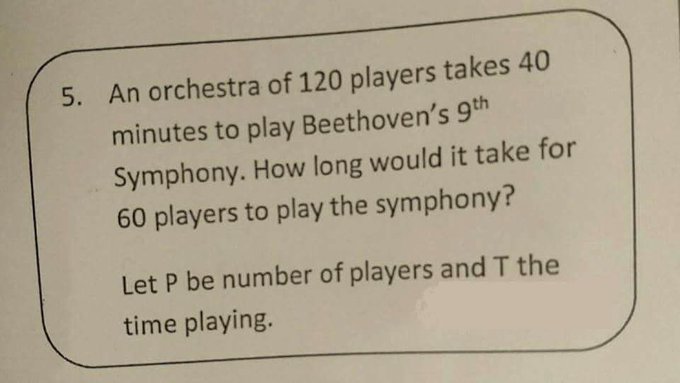Shared Work Word Problems
A few years ago, someone shared the following math problem on social media:
This particular math problem was actually intentionally written to be a trick question (the time taken to play the symphony is always the same, no matter how many players are in the orchestra), but at first glance it's an example of a classic type of word problem - the "shared work" problem.
Like most word problems, shared work problems can be difficult to initially set up, but aren't so bad once they've been translated into an equation. They are similar to distance/rate/time problems, but with an extra little twist. Let's look at a real example of one of those problems and talk about how to set them up and solve.
Becki and Ellie are cleaning the house together. If Becki were cleaning the house alone, it would take her 5 hours. If Ellie were cleaning by herself, it would take 7 hours. How long will it take them to finish the job together?
To start this problem, I'd recommend setting up a table to organize the information, just as we did for distance/rate/time problems. We'll still include "rate" and "time" columns; however, there's no travel involved, so having a "distance" column doesn't make sense. Instead we'll include a column for the amount of work completed. That being said, this "amount" column will function a lot like distance — it's still the rate multiplied by the time.

For the first two rows, we'll fill in the amounts based on Becki and Ellie each working by themselves. Becki cleaning alone takes 5 hours, so we put "5 hours" in the "time" column. The amount of work completed in those 5 hours is the entire house, so we'll put "1 house" in the "amount" column. Finally, we can combine those two pieces of information to fill in the "rate" column. The rate is the amount completed divided by the time to complete that amount: 1 house divided by 5 hours means she completes 1/5 of a house per hour. Similarly, Ellie can clean the whole house in 7 hours, so the amount is 1 house, the time is 7 hours, and the rate is 1/7 of a house per hour.

Finally, let's look at them working together. Their goal is to get the entire house clean, so the "amount" column will, once again, be "1 house." The time they'll take to get it done is unknown (it's what the problem is asking us to find), so we'll call it "x." Finally, the rate that they'll get the work done when they're working together is the sum of their individual rates - every hour, Becki will complete 1/5 of the house and Ellie will complete 1/7 of the house, so after one hour together they'll have (1/5 + 1/7) of the house done.

But wait! There's a second way to get the "rate" column for the "together" row! Just like the first two rows, the rate has to be the amount of work divided by the time - so when they work together, they're completing 1/x houses per hour.

And that's what ends up being the key to this problem: the 1/x and (1/5 + 1/7) are two different ways of writing the same thing — and if they're the same thing, then they must be equal to each other. That means we can turn that into an equation: 1/x = 1/5 + 1/7. Now all we have to do is solve that!
To solve the equation, let's start by simplifying the right-hand side. To simplify 1/5 + 1/7, we'll need to get a common denominator. Multiply the top and bottom of 1/5 by 7, and the top and bottom of 1/7 by 5, giving us 7/35 + 5/35. Once we have a common denominator, we add the numerators, so it's 12/35. So now we need to solve 1/x = 12/35 to find x.
Having x on the bottom of the fraction makes the algebra kind of tricky, so let's resolve that next by multiplying both sides by x, giving us 1 = 12/35 * x. Finally, to get x alone, we need to divide both sides by its coefficient, 12/35. Dividing by a fraction is the same as multiplying by its reciprocal, so we end up with 35/12 = x. So the girls working together can clean the entire house in 35/12 hours, or about 2.9167 hours.
Other shared work problems will work much the same way: you set up a table with amount, rate, and time, and you'll find that one of the boxes can be set up two different ways. Set those two different expressions equal since they represent the same thing, and then solve that equation to find the information you need.
So now you try! Solve the following problem and let me know your answer in the comments or on Facebook or Instagram.
Micah and Alexei are mowing lawns to earn money. If Micah can mow 3 lawns in 4 hours, and Alexei can mow 8 lawns in 9 hours, how many lawns can the two of them mow in 12 hours?

